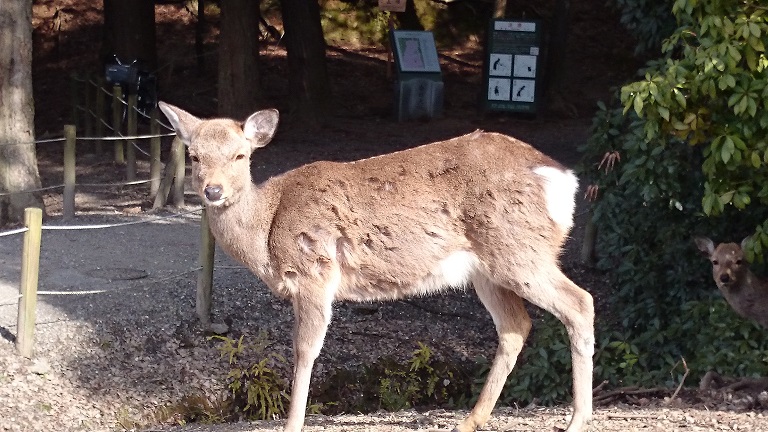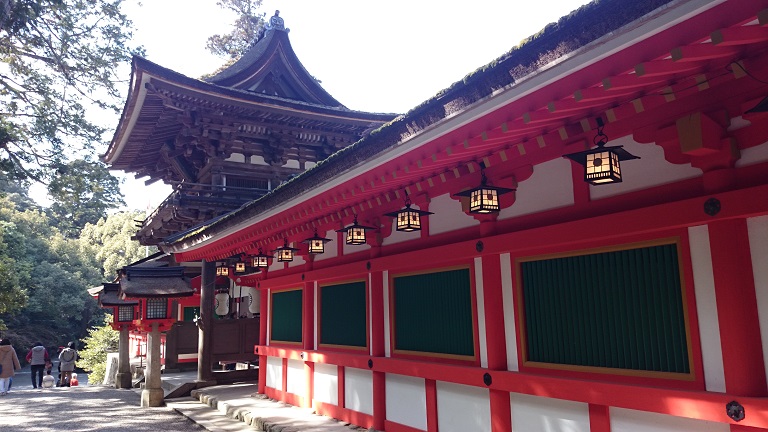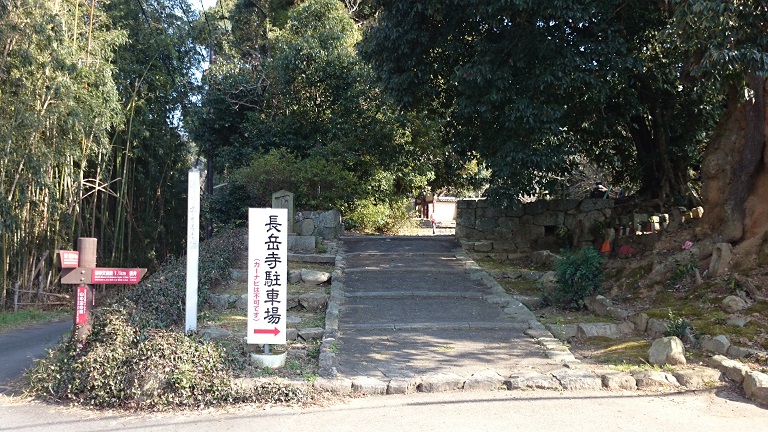山の辺の道 奈良から大神神社まで完歩 Tourist Information Yamanobe-no-Michi Complete Walk from Nara to Omiwa Shrine

近鉄奈良駅を9時に出発して16時までの7時間、ほぼ歩き通しで大神神社まで完歩しました。
I left Kintetsu Nara Station at 9:00 and walked almost all the way to Omiwa Shrine for 7 hours until 16:00.

興福寺南円堂(9:10)から春日大社(9:30)へ、奥の若宮、名前が気になった金龍神社(9:40)にお参りし、新薬師寺方面に出ました。
From Kofuku-ji Nanendo (9:10) to Kasuga Taisha (9:30), Wakamiya in the back, Kinryu Shrine (9:40) whose name I was curious about, and went out to Shinyakushiji.

風の無い晴天で太陽がポカポカと暖かく、いたるところで鹿がじっと立ったまま日向ぼっこしてます。(9:47)
It’s a sunny day with no wind and the sun is warm, and deer are standing still and basking in the sun everywhere. (9:47)

白毫寺の奥の東側山沿いで円照寺まで4.7kmの表示です。(10:01)
It is a display of 4.7 km to Enshoji along the east side mountain behind Byakugoji. (10:01)

民家や小さな里山を経ながら円照寺参道に出ました。(11:02)
After passing through a private house and a small village forest, I came out to the approach to Enshoji Temple. (11:02)

前にここで天理までまだ10km近くもあるので挫折して帯解駅から帰ったところです。
I just returned from Obioke Station after being frustrated because it was still about 10km to Tenri.

正歴寺「孔雀明王像」Shoreiji Temple “Peacock Myoo Statue”
山の辺の道からはすこし山奥にそれますが、正暦寺にはかつては数多くの堂塔伽藍が立ち並んでいたそうで、江戸時代前期の建立から唯一残っている福寿院客殿に珍しい孔雀明王がお祀りされています。
It’s a little farther into the mountains from Yamanobe-no-michi, but Shoryaku-ji used to have many temples and pagodas, and the Fukuju-in Kyakuden, the only remaining building from the early Edo period, houses the rare Peacock Myo-o. It is enshrined.

明王とは、密教が誕生した頃にヒンドゥー教の強力な神々を守護神に迎えて生まれた仏様で、「明」は悟りの知恵を意味し、その王である明王は仏教修行の道中で出遭うさまざまな誘惑や困難を乗り越えていくための力を得ていきます。その厳しさを表すために、如来や菩薩と違って怒りに燃えたような恐ろしい顔をしています。不動明王はその代表的なものですが、孔雀明王は菩薩のような姿をしており、孔雀の羽を背にして宝冠を被り座している均整の取れた姿は優美でさえあります。しかし、その優美なお姿からは想像もできませんが、サソリも食べ、毒蛇にも勝つといい、人間の迷いや煩悩を退治してくれる強力な仏様なのだそうです。
Myoo is a Buddha who was born with the powerful gods of Hinduism as guardian deities around the time Esoteric Buddhism was born. You will gain the strength to overcome the various temptations and difficulties you encounter. In order to express his severity, he has a frightening face that burns with anger, unlike Tathagatas and Bodhisattvas. Fudo Myoo is a representative example of this, but Kujaku Myoo looks like a Bodhisattva, and its well-proportioned figure sitting in a coronet with peacock feathers behind it is even graceful. However, it is hard to imagine from its graceful appearance, but it is said that it eats scorpions and overcomes poisonous snakes, and is said to be a powerful Buddha that exterminates human confusion and worldly desires.
さて、円照寺から2.5㎞と表示された弘仁寺を目指して、普通の村落の中を山の方に向って歩いていきます。弘仁寺は山の中のひっそりとしたところにあり、入山に200円かかります。本堂の中からはお経を読む声が聞こえました。(11:37)
Now, aiming for Koninji Temple, which is indicated as 2.5km from Enshoji Temple, we will walk towards the mountains through an ordinary village. Koninji Temple is located in a quiet place in the mountains, and it costs 200 yen to enter. I heard voices reading sutras from inside the main hall. (11:37)

天理高校か大学の野球グランドの横を通って白川溜池に着きますが(12:09)、石上神社まではまだ5キロ弱あります。
After passing by the Tenri High School or university baseball grounds, I arrived at Shirakawa Tameike (12:09), but Ishigami Shrine was still less than 5 kilometers away.

近鉄奈良駅から4時間、13時10分にようやく石上神社に到着しました。
Four hours from Kintetsu Nara Station, we finally arrived at Isonokami Shrine at 13:10.

都会の喧騒を離れて静かな神社には鶏が放し飼いにされており、太古を感じる雰囲気でした。
Away from the hustle and bustle of the city, the quiet shrine has free-ranging chickens, giving it an ancient atmosphere.

靴底が薄いためか足裏にいくつもマメができ正直心が折れそうでしたが、時間も早いし、今日こそは三輪まで完歩したくてとにかく進むことにしました。そこからはのどかな梅林の間を抜けて、大和盆地を右手に見下ろしながら気持ちの良い南山の辺の道です。
Maybe because the soles are thin, I got a lot of blisters on the soles of my feet, and to be honest, I felt like I was going to break my heart, but it was too early, and today I wanted to complete all the steps to Miwa, so I decided to go ahead anyway. From there, you will pass through the idyllic plum groves, looking down on the Yamato Basin on your right, and take the pleasant Minamiyama-no-be road.

南山の辺の道は北よりも歩きやすく、まずは夜都伎神社に着きました。「×ヨトギ」ではなく「〇ヤツギ」神社です。(13:50)
The road on the side of Minamiyama is easier to walk than the road on the north side. It is a shrine of “○ Yatsugi” instead of “× Yotogi”. (13:50)

そこから進むと大和盆地を見晴らしながら歩く気持ちの良い道で、
Proceeding from there, it is a pleasant road to walk while overlooking the Yamato Basin,

途中には菜の花畑(14:05)や梅林があり、春はここがすごくいいことを再認識しました。
There are fields of rape blossoms (14:05) and plum groves along the way.

靴を足底が丈夫なのに変えたので前半は好調でしたが、やがてマメができる気配がしてきました。やがて長岳寺に着くと案内所もあり、観光客がたくさんいます。(14:37)天理と奈良の中間点のイメージです。
I changed my shoes even though the soles are strong, so I was doing well in the first half, but soon I started to feel like I was getting blisters. Eventually, when you arrive at Chogakuji Temple, there is an information office, and there are many tourists. (14:37) This is an image of the midpoint between Tenri and Nara.

長岳寺「阿弥陀如来三尊像」Chogakuji “Amida Nyorai Triad”
仏像彫刻の目の表現には、描いたり掘ったりする以外に水晶をはめ込むという技法があり、人間の瞳のようにきらりと光る目、これを「玉眼」と言い、日本で初めて用いた仏像が山の辺の道の長岳寺にあります。人の眼のように光りとてもリアルなので、造られた平安後期にはとても画期的な出来事だったのでしょう。この頃は穏やかで優しい美しさの定朝スタイルが主流でしたが、長岳寺の阿弥陀如来様は丸く張りのあるお顔、肉付きのよい身体、量感のある衲衣のひだなど、玉眼以外も温和な定朝スタイルとは異なり、新しい仏像彫刻の先駆けとなるエポックメイキングな仏像です。
In addition to drawing and engraving the eyes of Buddha statues, there is a technique of inlaying crystals, and the eyes that shine like human eyes are called “gyokugan”, and were the first Buddhist statues in Japan to use them. is located at Chogakuji Temple on the mountainside road. It shines like a human eye and is very realistic, so it must have been a very epoch-making event in the late Heian period when it was built. At this time, the Jocho style of calm and gentle beauty was the mainstream, but Amida Nyorai of Chogakuji has a round and firm face, a well-fleshed body, and voluminous folds of the kimono, and is gentle other than the eyes. Unlike the Jocho style, this is an epoch-making Buddha statue that will be the forerunner of new Buddha sculpture.

長岳寺は9世紀に大和神社の神宮寺として空海によって創建された古刹で、12世紀には興福寺の門跡寺として摂関家の子弟を迎えていました。だから仏像も興福寺に所属する仏師が造ったと言われていますが、平安時代に奈良の古仏を修理する日々の中で奈良の彫刻技術を身につけ、京都とは違う美意識を磨いていった奈良仏師(後の運慶につながる系譜)の手によってこの阿弥陀如来様が造られたれました。運慶が円成寺の大日如来でデビューする25年前のことですが、その後、興福寺は平家による焼き討ちで全山炎上し、鎌倉幕府の誕生へと時代は大きく変わります。そのような時期に変化の予兆のように現れた仏様です。
Chogaku-ji is an ancient temple founded by Kukai as the Jingu-ji of Yamato-jinja Shrine in the 9th century. Therefore, it is said that Buddhist statues were made by Buddhist sculptors belonging to Kofuku-ji Temple, but during the Heian period, they learned the carving techniques of Nara while repairing old Buddhist statues in Nara, and developed an aesthetic sense different from that of Kyoto. This Amida Nyorai was created by a Nara Buddhist sculptor (a genealogy that would later lead to Unkei). It was 25 years before Unkei made his debut as Dainichi Nyorai at Enjoji Temple, but after that, Kofuku-ji Temple was set ablaze by the Heike clan, and the times changed dramatically with the birth of the Kamakura Shogunate. It is a Buddha who appeared like a sign of change at such a time.
道端には果物や野菜の無人販売(14:54)や、ちょっとした喫茶店、手作り陶芸(15:10)などもあり楽しい雰囲気です。
There are unmanned sales of fruits and vegetables on the roadside (14:54), a small coffee shop, and handmade pottery (15:10).



もっと高級なもの(2~3万円の)を買わないといけなかったのか?ただ、今日の目標は山の辺の道終点にそびえる前方の三輪山です。
Did I have to buy something more expensive (20,000 to 30,000 yen)? However, today’s goal is Mt. Miwa, which rises at the end of Yamanobe Road. I can’t stop coming here.まで来て止めるわけにいきません。

前回へとへとで着いた桧原神社を通過しました。檜原神社があります、ここは本殿どころか拝殿もなく、原始的信仰を守り続けています。檜原神社は「元伊勢」と呼ばれ、伊勢神宮の斎宮と同緯度線上に並んでいます。
I passed the Hibara Shrine where I arrived exhausted last time. There is Hinohara Shrine, which has no worship hall, let alone the main shrine, and continues to protect primitive beliefs. Hinohara Shrine is called “Motoise” and is located on the same latitude line as the Saigu of Ise Jingu.

ようやく狭井神社に到着しました。
Finally, we arrived at Sai Shrine.

16時に大神神社に到着し、春日和の楽しいウォーキングは厳しい一日修行となりました。大神神社や石上神宮は、どちらも拝殿はありますが本殿はなく、神は建造物ではなく、山や依り代となる樹木、磐座といった自然のものに舞い降りてくるというそうです。
We arrived at Omiwa Shrine at 16:00, and the fun walking in Kasugawa turned into a tough day of training. Both Omiwa Shrine and Isonokami Shrine have worship halls, but no main shrines.

南山の辺の道は観光気分で歩けて楽しい感高いのですが、7時間30㎞歩きは結構応えました。
It was fun to walk along the roads around Nanzan, but walking 30km in 7 hours was quite rewarding.

さらに山の辺の道の起点である「海柘榴市」まで行きました。
Furthermore, I went to the starting point of Yamanobe-no-Michi, the Umi Zakuro Market.

そこから桜井駅までの1.7㎞が余計にしんどくて30分以上よちよちとロボコップのように満身創痍で歩いて帰りました。
The 1.7 km from there to Sakurai Station was extra tough, so I walked home with wounds all over like RoboCop for more than 30 minutes.
おまけ<三輪山ご参拝登山> Bonus
狭井神社では住所氏名を記入して300円支払い、自分でお祓いをしてすぐに登山です。入口に置いてある竹が杖替わりで嬉しいです。ここは御神体の山に登るので写真撮影禁止で、標高差400メートルを登り1時間くらいで登攀します。
At Sai Shrine, fill in your name and address and pay 300 yen. I am glad that the bamboo placed at the entrance can be used as a cane. Since this is a sacred mountain, photography is prohibited, and it takes about an hour to climb an altitude difference of 400 meters.

私たちの前の数人の若者たちが、受付の神職から手厳しい注意を受けています。登山気分で登るなとか、修行で真剣に登ている人がいるので登山のように「こんにちわ」と挨拶するなとか、弁当などの飲食しないことなど、もう登るなと言わんばかりの注意です。
A few young people ahead of us are receiving harsh attention from the receptionist priest. Don’t climb in the mood for mountain climbing, don’t say “Hello” to someone who is seriously training to climb, don’t eat and drink such as lunch boxes, etc.

3の標識あるところに、滝に打たれて修行する行場があります。(撮影禁止なのでネット写真より)
At the place where there is a sign of 3, there is a training place where you can practice by being hit by a waterfall. (From the internet photo because photography is prohibited)


小一時間ほど登り、8という標識のあるところが頂上の社です。神秘的な雰囲気があります。(撮影禁止なのでネット写真より)
After climbing for about an hour, the place with the sign 8 is the shrine at the top. It has a mysterious atmosphere. (From the internet photo because photography is prohibited)

さらに平たんな道を少し進んだ先には、大きな岩がごろごろ転がっている神域があります。飛鳥時代の前にはこの三輪山のふもとに古代王朝があったようですが、そのころは巨石を使う時代だったようで、太陽の出てくる東に位置していたことに加えて、山頂にこのような巨石がたくさんあったので、この山が神聖なるご神体とされたのかもしれません。(撮影禁止なのでネット写真より)
A little further along the flat road, there is a sacred area with large rocks lying around. It seems that there was an ancient dynasty at the foot of Mt. Miwa before the Asuka period. There were many such megaliths in Japan, so this mountain may have been considered a sacred object. (From the internet photo because photography is prohibited)

頂上には、まず高宮神社の小さな社があり、そこから少し先に行くと奥津磐座という神聖な場所があります。山頂にたくさんの石があり、それが神聖な場所なのです。たくさんの人が登ってきていますが、みんな飲食禁止も守り、登ったらすぐに下山していき、たいへんマナーがいいです。(撮影禁止なのでネット写真より)
At the summit, there is the small shrine of Takamiya Shrine, and a little further on is the sacred place called Okutsuiwaza. There are many stones on the top of the mountain, and it is a sacred place. There are a lot of people climbing up, but everyone has a very good manner, not eating and drinking, and descending immediately after climbing. (From the internet photo because photography is prohibited)

最後に撮影できなかった頂上の写真がネットに出ていました。こんな感じでした。
A photo of the summit that I couldn’t take at the end was on the internet. It was like this.

登拝を終えて、二の鳥居前の「森正」でにゅうめん850円頂きました。
After finishing the worship-ascent, I got nyumen for 850 yen at “Morimasa” in front of the second torii.

とても感じのいいつくりの店ですが、予約客以外は屋外のようで、管内の庭を眺めながらの座敷と思っていたので少し拍子抜けでした。
It’s a very pleasant restaurant, but it seems that everyone other than the reservation customers is outdoors, and I thought it was a tatami room overlooking the garden of the jurisdiction, so it was a little disappointing.





